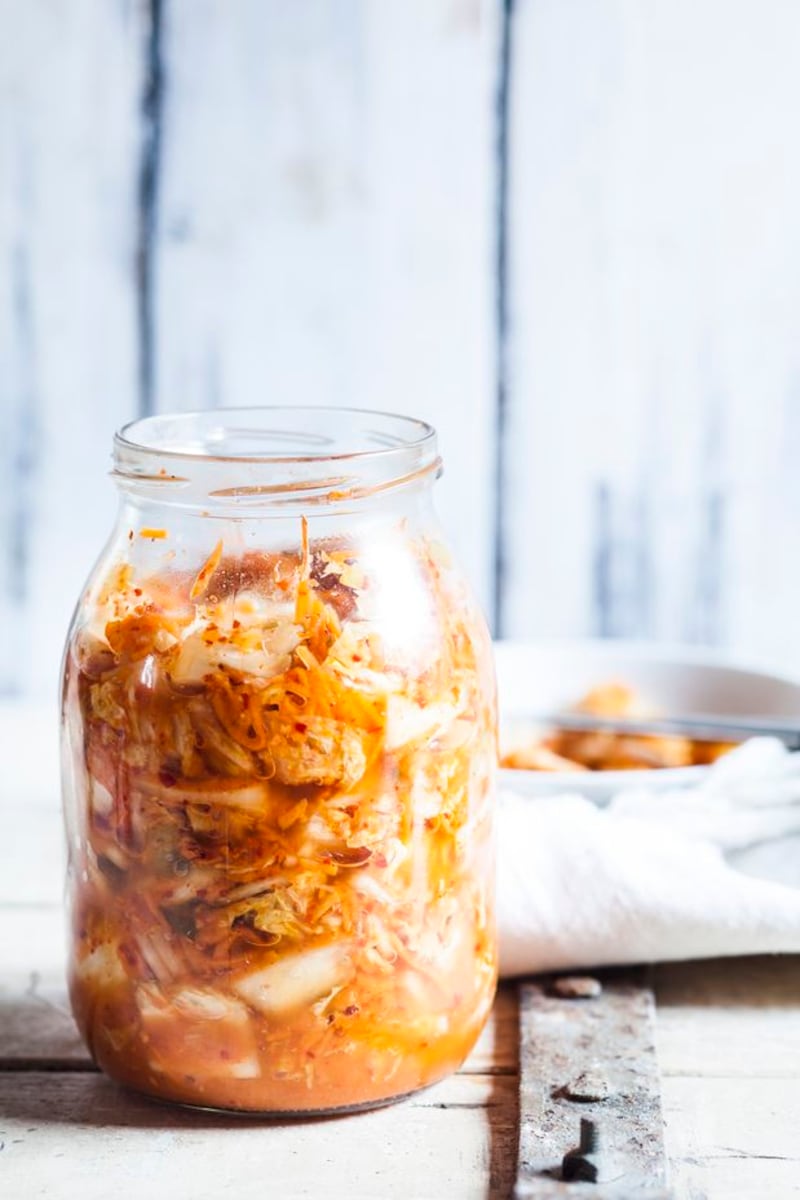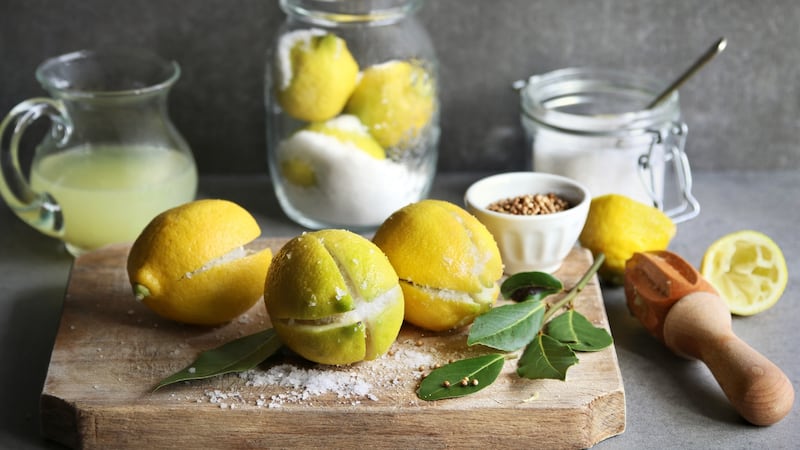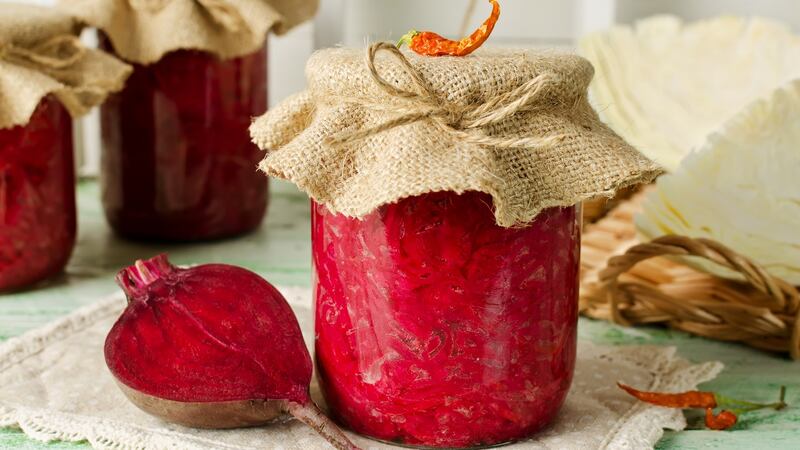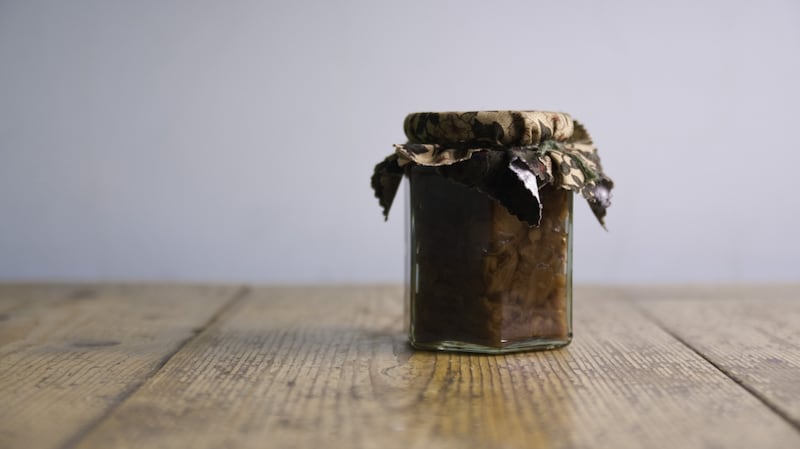Over the years I’ve had numerous people come to train with me in the kitchen, and each came with their own ideas, techniques, skills and gifts. I have so many fond memories and we, as a family, share many happy stories of visitors.
Last week Lauren, who is Korean and was brought up in California, came back to dine with us from Berlin. It was eight years since she spent a summer with us in the kitchen. Her biggest gift to us was introducing us to the health benefits of fermented foods in our diet. Lauren is not only a chef, an opera singer and gifted healer, she now runs a kimchi-focused food business in Germany.
I can recall vividly when she told me I had no “good gut bacteria” and I needed to be consuming fermented foods and drinks. I had no idea what she was talking about and it took me some time to understand the whole process.
Within a few weeks we were serving kimchi – a fermented Korean cabbage condiment – with our roast chicken and educating our customers. I was preserving lemons, eating aged cheeses, drinking cider vinegar and had made sauerkraut and sourdough bread over the years, but didn’t understand the process and the full extent of their health benefits.
This process preserves the food and creates lots of goodness
Fast forward and, today, fermented food and drink is on trend and readily available in many shops and food markets here in Ireland. If you have not introduced them into your diet, there are many reasons why you should.
Fermented foods are foods that have been through a process of lactofermenation, in which natural bacteria feed on the sugar and starch in the food creating lactic acid. This process preserves the food and creates lots of goodness along the way: B-vitamins, omega 3 fatty acids and probiotics, as well as the goodness of the vegetables and spices.
I must admit that on first encountering fermented foods, you may be a little overwhelmed by the odour and sometimes the taste. Avoid a deep breath as you open the jar! But do persist and introduce them slowly into your diet, in very small quantities, but eaten often, and I promise your body will start to crave that feel-good factor that they give .
KIMCHI

This is based on Lauren’s family recipe but I have added seaweed instead of oysters and I’ve dropped the fish sauce to make it vegan-friendly. I always use cabbage, onion and apple along with the spices, and after that I am happy to add carrots if I can’t find any daikon radish or kohlrabi – although these are now more available, especially in Polish shops. The Korean chilli powder is in most Asian food stores or you can order it online. Do try to find it, as it has a sweetness and isn’t as hot as other chilli powder or flakes.
Ingredients
160g rice flour
1.8l water
175g Kochugaru (Korean chilli powder)
8 tablespoons sugar
150g seaweed flakes
4 apples, grated
4 onions, pureed
40 cloves of garlic, finely minced or pureed
3/4 cup ginger, minced or pureed
2 medium heads of cabbage
4 Bunches of spring onions, julienned
2 Daikon Radish (or 4 Kohlrabi), finely julienned
Method
1. Place the flour and water in a small saucepan and cook over medium heat, stirring constantly to avoid lumps.
2. When it starts to bubble and thicken into a porridge, remove from the heat and add the sugar. Mix well and let cool.
3. Once the flour mixture has cooled to room temperature, add the rest of the ingredients and mix well.
4. You can adjust the amount of chilli powder to suit your taste.
5. Take two sterilised, ring lock (kilner) preserving jars and and fill with the mixture to about 3/4 way, making sure all the vegetables are covered in liquid. Leave to stand in the kitchen overnight with the lid open, but covered with a tea towel to allow the fermentation process to begin.
6. Depending on the time of year and the temperature of your house this can take up to three days. It's ready to store once it gives off a slightly pungent smell – this means it has started to ferment.
7. Move to the fridge, where it will keep for months. It is ready to eat at once but the longer you leave it, the better the flavour and health benefits.
PRESERVED LEMONS

I keep these in the fridge to add to fish, salads, meats and to finish off a noodle or rice dish.
Ingredients
4 organic, unwaxed lemons
1 tsp coarse sea salt
A couple of cinnamon sticks
10ml (2 tsp) coriander seeds
2.5 ml (1/2 tsp) black peppercorns
2 or 3 bay leaves
Olive oil
Method
1. Wash the lemons and quarter each one lengthways, but don't cut all the way through. You should end up with lemons that open like flowers.
2. Take each one and, holding it half open, put about 2 tsp of salt into it.
3. Squeeze it closed and put into a sterilised jar. Do this with all the lemons, then put a weight on top of them (weighing scale weights work well), cover with a lid, and leave them in a warm place for a few days while the juices run out.
4. Remove the weight and add the cinnamon sticks, coriander seeds, peppercorns and bay leaves by eye getting a nice balance. Add enough fresh lemon juice to cover the lemons completely, then pour a layer of olive oil on top, making sure none are peeping out.
5. Store in a dark cold place and they will be ready to use in about a month.
BEETROOT KIMCHI

This recipe comes from Clovisse Ferguson who spent a summer in the kitchen with us and is now an expert in all things fermented.
Ingredients
3 large beetroots, peeled
3 big garlic cloves, chopped
3 spring onions, chopped
3 inches of garlic, chopped
3 chillies, chopped
1 tbsp salt
Method
1. In a food processor – or by hand – grate the beets finely and put in a large bowl, along with the rest of the ingredients.
2. Next, massage all the ingredients together until the juice starts to run from the vegetables. (You might want to wear gloves to stop the beets staining your hands.)
3. Pack the mixture tightly into a preserving jar, filling only 3/4 of the way, as it needs room to ferment. Place a disk of greaseproof paper directly on the beetroot, then place a weight on top to keep the ingredients submerged.
4. Seal with the lid, and leave at room temperature for about four or five days, opening to release the pressure daily.
5. Once it's done, store in the fridge and use it with cheeses, meats or as a topping on noodle and rice dishes.
APPLE-AND-DATE CHUTNEY

As a rule I am not a fan of chutneys as I find them too heavy and sweet but this one is a winner. It makes a great side to curries, cheeses, bean burgers and cold meats.
Ingredients
1.5kg apples, any variety, unpeeled
500g pitted dates
550g Demerara sugar
1/2 litre cider vinegar
100ml olive oil
1tbsp coriander seeds
1tbsp fennel seeds
2tbsp cumin seeds
1/4 teaspoon ground chilli powder
750g onions, peeled and finely sliced
500g carrots, grated
1 tbsp sea salt
Method
1. Wash the apples, cut them into quarters and remove the cores, then chop each quarter into three chunks.
2. In a large bowl, mix the apples and dates with the sugar and vinegar and leave to sit for an hour.
3. Heat the oil in a pot large enough to take all of the mixture and, once its smoking, add the seeds and chilli powder. Fry for half a minute, stirring well, and then add the onions and fry for three minutes, stirring continuously.
4. Add the carrots and cook for five more minutes.
5. Add the fruit mixture and salt and slowly bring to the boil, stirring constantly. When it comes to the boil, turn the heat down to a rapid simmer and cook for 45 minutes, stirring every 10 minutes. Make sure to scrape the bottom and sides of the pot to ensure that nothing sticks or burns.
6. Heat some glass or ceramic jars with hot water for a few minutes. Tip out the water and spoon in the chutney almost to the top. Screw on the lids and let the jars cool.
7. Store in the fridge or a cool dark cupboard, where the chutney will keep for a few months.

















